Crafting a refund policy might be overlooked by many new online store owners, often relegated to the bottom of their to-do lists. However, neglecting it could be detrimental. Research suggests that 67% of shoppers review the returns page before making a purchase, indicating its significance.
A robust refund policy not only instills trust in your store but also aids in managing expectations, both yours and your customers’. So, how do you go about drafting one? In this article, I’ll guide you through understanding what a refund policy entails, the essential components of a quality policy, provide examples, and offer a downloadable refund policy template.
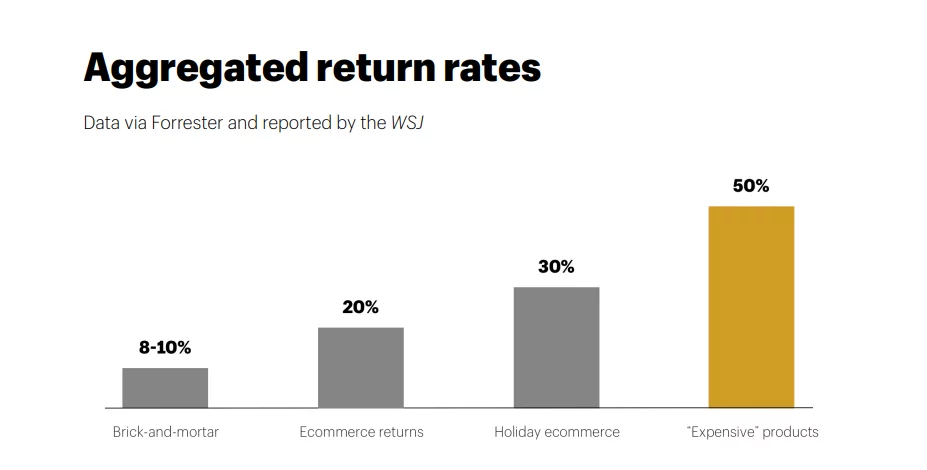
A return policy is a set of guidelines that outline how a business handles customer returns. It serves as a framework for businesses to manage the process when customers need to return an item for various reasons.
Having a return policy is crucial for several reasons:
- Building trust: A clear and fair return policy acts as a safety net for customers, allowing them to shop confidently knowing they can return items if needed.
- Increasing revenue: Easy returns can lead to repeat business, as 92% of consumers are more likely to buy again if the return process is hassle-free.
- Protecting your bottom line: A well-defined return policy helps prevent fraudulent returns and sets expectations for customer interactions, safeguarding your business interests.
A return policy serves as a guideline for how a business handles customer returns, outlining the rules and procedures when customers need to return items for various reasons.
However, it’s more than just setting rules. A clear and fair return policy is essential because:
- It builds trust: Customers view a return policy as a safety net, allowing them to shop confidently without fear of losing out. This trust can lead to repeat business.
- It increases revenue: Easy returns encourage customers to buy again, with 92% of consumers more likely to make a purchase if the return process is simple.
- It protects your bottom line: A well-defined return policy helps prevent fraudulent returns and sets expectations for customer interactions, safeguarding your business interests.
Additionally, it’s important to understand the difference between a return policy and a refund policy. While the former outlines the conditions and timeline for returning items, the latter focuses on how customers will be compensated for their returned purchases.
To ensure your return policy is accessible to customers, consider placing it in various locations such as the footer of your website, email newsletters, order confirmation emails, and during the checkout process. This ensures customers can easily find and understand your return policy before making a purchase.
Finally, there are different types of return policies to consider, such as exchange-only policies, full refund policies, store credit policies, and warranty policies. Each type caters to different customer needs and preferences, so it’s essential to choose the one that aligns best with your business and brand voice.
Having a return policy in place can help prevent fraudulent returns and establish clear expectations for customer interactions with your store.
Learn about return fraud here.
Return Policy vs. Refund Policy: What’s The Difference?
Although “return policy” and “refund policy” are often used interchangeably, they have distinct meanings.
A return policy outlines the timeline and conditions for returning an item, while a refund policy specifies how customers will be compensated for their returned purchases.
Combining both policies into one document is a common and practical approach, considering the ease of access for customers and simplification of information.
Where Should You Display Your Return Policy?
Your return policy can find a place in four key locations (or even all of them):
- Website Footer:

The footer of your website serves as an ideal spot for your return policy since it’s visible across all pages. Keep it simple, like 4Ocean does, with a straightforward placement.
- Email Newsletters:

Integrating your return policy into email newsletters is beneficial for both existing and potential customers. Ensure it’s prominent, as exemplified by Brooklinen, to influence purchasing decisions positively.
- Order Confirmation Emails:

Though you might hesitate to include your return policy here, as it’s post-purchase, it’s still valuable for fostering lasting customer relationships. ASOS subtly incorporates theirs into order confirmation emails, contributing to customer satisfaction.
- Checkout Process:

Embedding your return policy within the checkout page enables customers to review it before finalizing their purchase. You can either link to a dedicated page or, like North Face, seamlessly integrate it into the checkout process for convenience.
By strategically placing your return policy across these touchpoints, you enhance customer trust and facilitate smoother transactions.
Key Elements of a Return Policy:
1. Return Policy Duration
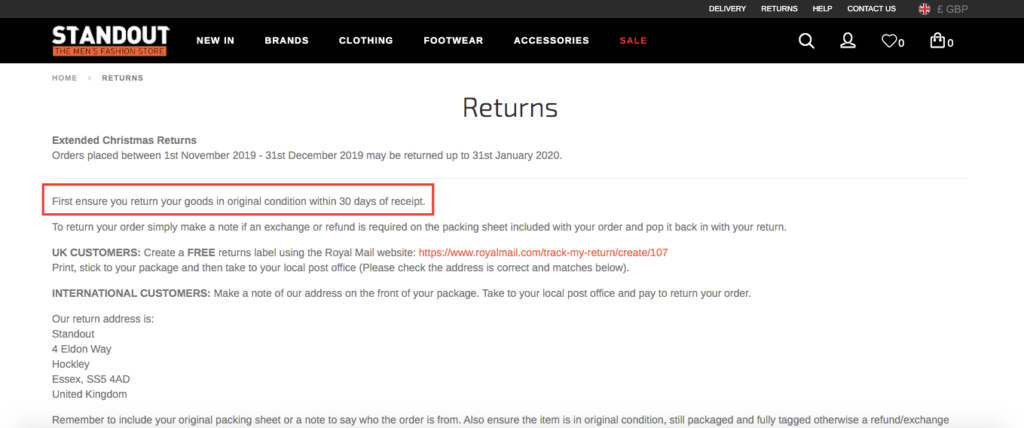
One of the initial details to address is the timeframe within which customers can initiate a return.
Standout, a UK men’s fashion retailer, strategically places this information near the top of their returns page, just below extended Christmas returns. This placement ensures easy accessibility for shoppers, eliminating the need for extensive navigation. Speaking of which, you might be pondering the optimal duration for customer returns.
Extensive research indicates that a 30-day window is favorable, with 53 percent of customers deeming it an equitable timeframe.
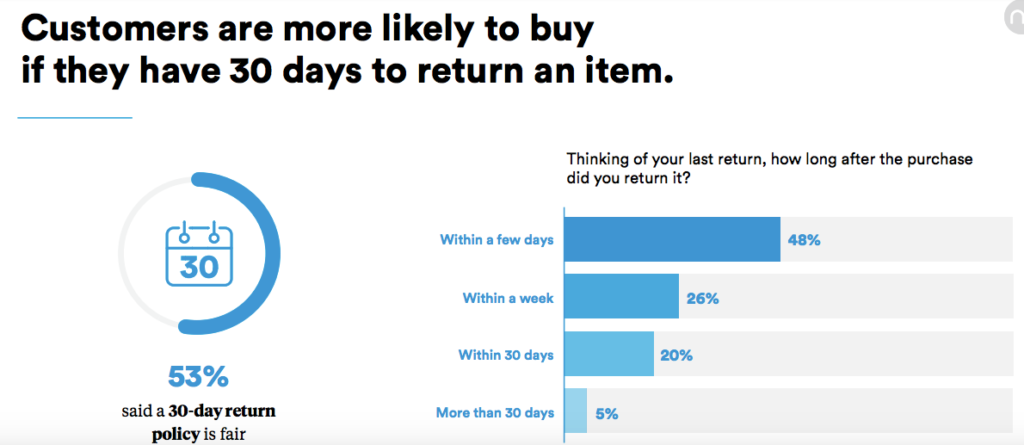
Analyzing the graph on the right reveals that merely 5 percent of customers waited beyond 30 days for their last return, affirming the adequacy of this duration for most brands.
2. Return Shipping Costs
Following the duration of the return policy, customers typically seek clarification on any associated costs for returns.
To address this concern promptly, I recommend placing this information directly below the return policy timeframe. This layout approach is adopted by Allbirds, an environmentally conscious shoe brand.
Notably, Allbirds offers customers the convenience of free returns—an aspect deemed crucial by 79 percent of shoppers who prefer not to incur return shipping charges.
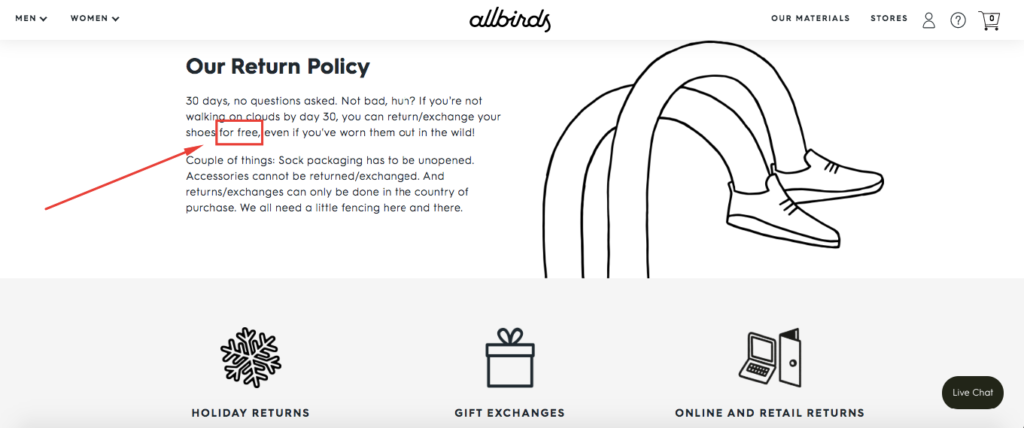
“In a landscape where free shipping is the norm for online purchases, the prospect of shouldering return shipping costs is met with discontent,” elucidates ecommerce CRM platform ReadyCloud.
While implementing free returns may impact profit margins, the resultant enhancement in customer loyalty and repeat business often outweighs this expenditure.
I advise conducting a thorough financial analysis to ascertain the feasibility of this practice for your company.
3. Receipt Requirements
Some brands enforce strict policies necessitating a receipt for returns, with no exceptions allowed.
Given the convenience of digital receipts retrievable via email, this requirement typically poses no inconvenience for customers.
Conversely, other brands adopt a more lenient approach, waiving the receipt requirement provided customers furnish alternative information enabling purchase identification.
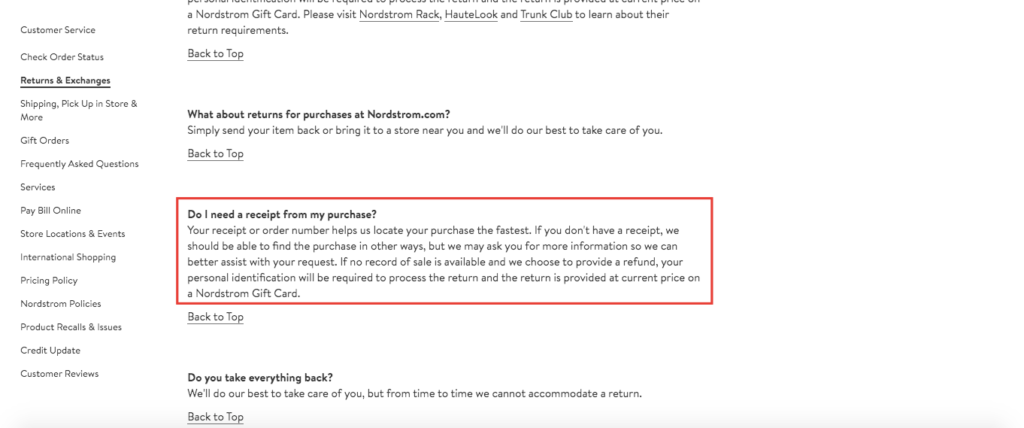
Regardless of the chosen stance, it’s imperative to communicate your receipt policy clearly to shoppers.
Nordstrom exemplifies effective communication in this regard on their returns page, articulating that while having a receipt expedites the process, it’s not mandatory as long as a record of sale can be located or customers are willing to provide relevant personal details.
Clarifying your receipt policy not only saves time for customers but also streamlines operations for your company, minimizing potential back-and-forth interactions.
4. Policy on Damaged Items
Did you realize that a significant reason why 20 percent of ecommerce customers return items is due to damage? That’s one in every five transactions.
This statistic underscores the critical importance of addressing your stance on damaged items in your return policy.
Milani Cosmetics adopts a straightforward approach, stating that they will provide customers with a refund or exchange for any damaged items, provided customers first email them pictures.
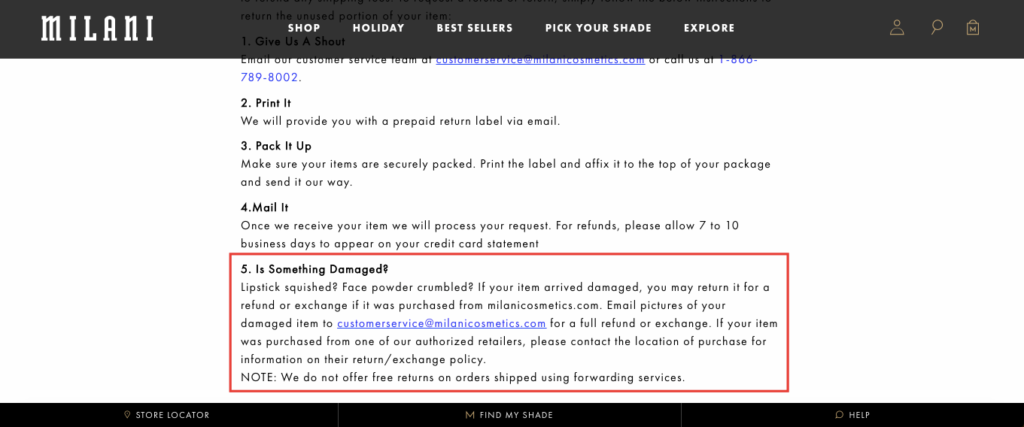
Including this provision in your policy ensures alignment from the outset, empowering customers with clear instructions on handling damaged products.
5. Requirements for Product Condition
Return policies may vary concerning the condition in which products must be returned. For example, Zazzle, an on-demand t-shirt company, permits returns regardless of the product’s condition, without any specific stipulations.
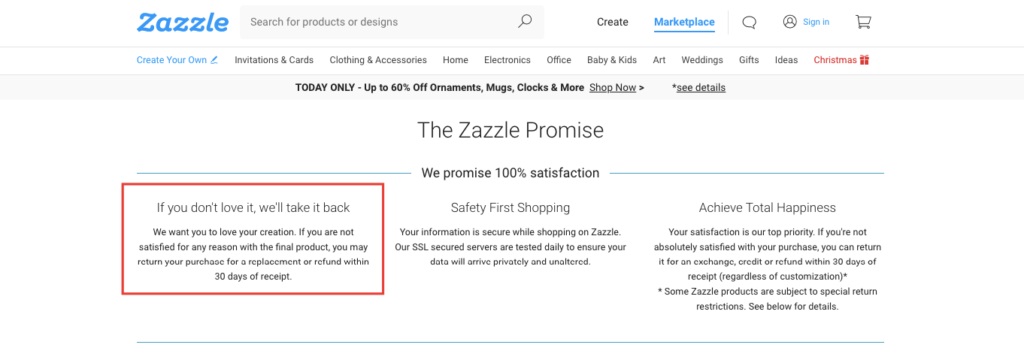
Conversely, Allbirds mandates that sock packaging must remain unopened for eligibility for return, and accessories are ineligible for return or exchange.
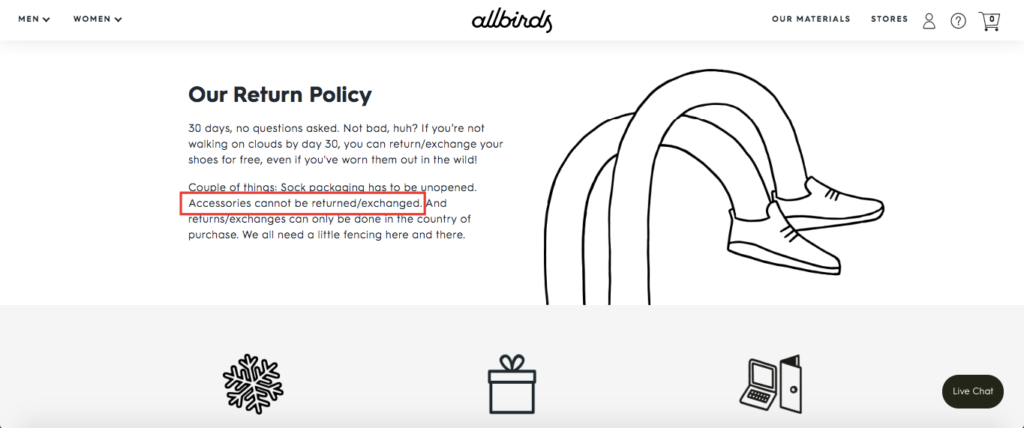
Similarly, Oak Hall, a men’s and women’s clothing store, specifies that items must be unworn, unwashed, and undamaged for returns or exchanges.
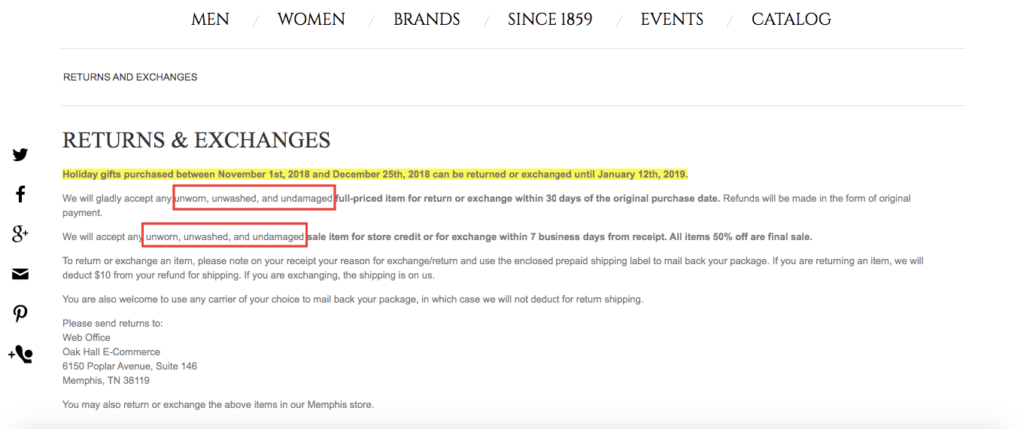
Incorporating these condition requirements, along with delineating products ineligible for exchange, fosters immediate transparency and equips shoppers with essential information. This transparent approach not only builds trust but also cultivates a positive rapport with customers.
6. Refund Destination Clarification
A common inquiry among customers pertains to the method by which they’ll receive their refund. Will the funds be deposited back into the original debit or credit account used for the purchase? Alternatively, will they receive a gift card, or can they opt for cash reimbursement?
To ensure a seamless customer experience, it’s imperative to unequivocally outline the available options.
For example, Nordstrom specifies, “All refunds will be credited to your original form of payment or a Nordstrom Gift Card.”
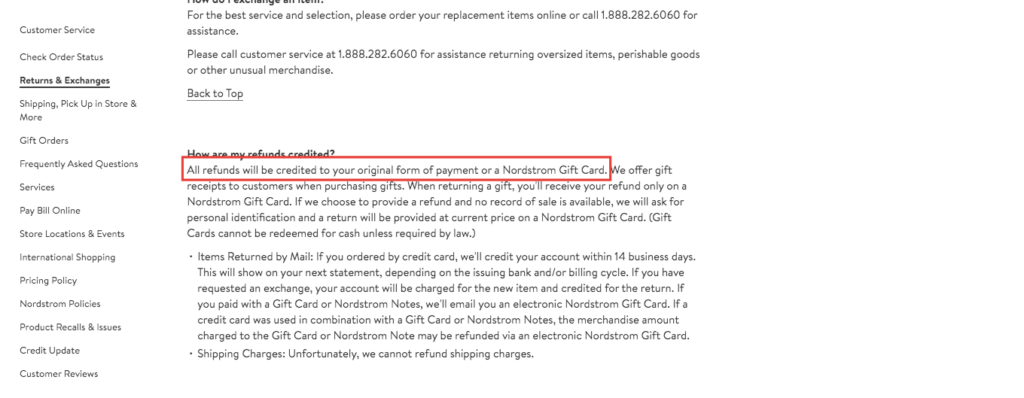
This leads to the next point.
7. Replacement or Exchange Options
While some customers may prefer a straightforward refund, many seek alternatives such as item exchanges or store credit, akin to Nordstrom’s offering of gift cards.
In fact, statistics reveal that 28 percent of shoppers favor exchanging a product for other items, while 35 percent appreciate the option of immediate credit.
Thus, it’s crucial to elucidate your policies regarding replacements or exchanges, clarifying if such options are available.

GitiOnline exemplifies this clarity by addressing it upfront. Additionally, they specify that a select few heavily discounted items are ineligible for replacement or exchange.
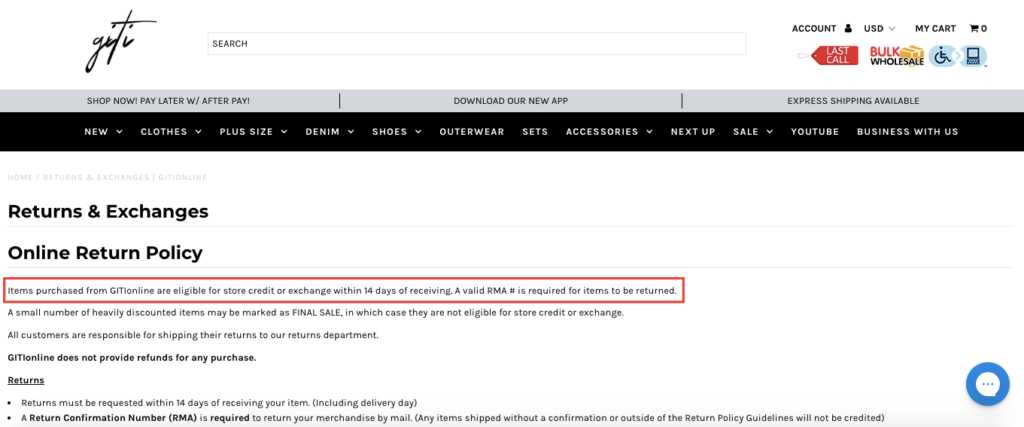
Failure to communicate such exceptions could potentially result in customer dissatisfaction, underscoring the importance of incorporating this information into your refund policies.
8. Refund Processing Timeframe
Addressing the duration required for refund processing is paramount, as it significantly influences the overall customer experience.
Research underscores the impact of slow processing on customer sentiment:
- Seventy-seven percent of customers are less inclined to recommend a brand that delays issuing a credit.
- Forty percent are inclined to cease shopping online with that brand.
- Forty percent will curtail their shopping activities with that brand.
Given the irritation associated with prolonged refund timelines, it’s imperative to specify the processing duration, as exemplified by Milani Cosmetics below.
Data suggests that customers generally expect swift processing:
- Seventy-two percent are willing to wait up to five days.
- Twenty-four percent are amenable to a ten-day timeframe.
- Three percent are willing to extend to 20 days.
- One percent are prepared to wait beyond 20 days.
Ideally, processing should be completed within five days, with a ten-day threshold generally considered acceptable. However, exceeding a 20-day timeframe is likely to lead to customer dissatisfaction and potential issues.
9. Accessing Return Labels
Ensuring customers can easily locate their return labels is paramount to a smooth return process. The last thing you want is for them to encounter difficulty in printing and sending back their items. Therefore, it’s crucial to streamline this aspect as much as possible.
I appreciate how Standout simplifies this process by offering a prominently displayed link on their returns page.
With just a click, customers are guided through a straightforward three-step process, enabling them to print their label conveniently from home.
Standout’s approach serves as an exemplary template to emulate.
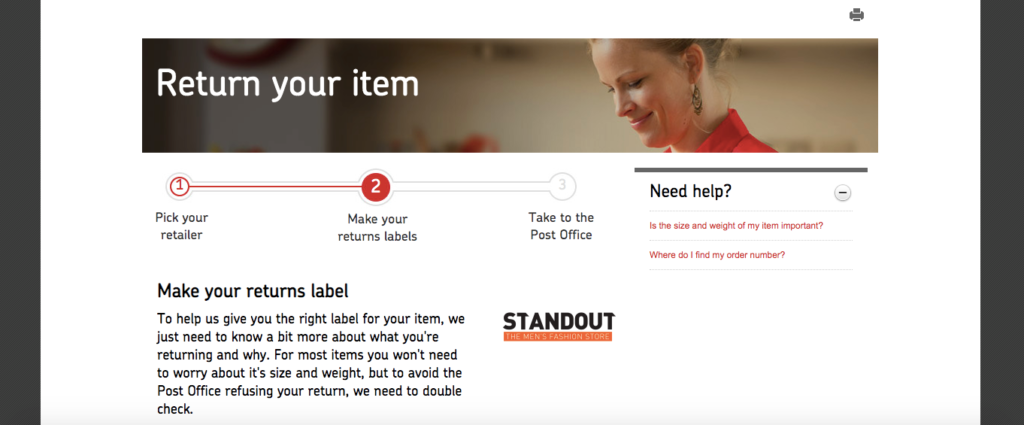
Conclusion:
The question of “How to write a refund policy” is inherently tied to the unique characteristics of each business. While the fundamental principles remain consistent, there are nuanced details that must be tailored to suit the particularities of each store, especially regarding the type of refund policy.
For instance, North Face boasts a distinctive return policy, complete with its lifetime warranty, while ASOS tailors its return policy to accommodate its extensive product range.
Likewise, it’s imperative to craft a return policy that aligns with the specific needs of your clientele while safeguarding the interests of your business.
Much like how a robust return policy fosters trust and loyalty among customers, an effective email program can yield similar benefits.
Sending targeted messages to the appropriate recipients at opportune moments can significantly differentiate you from your competitors.



